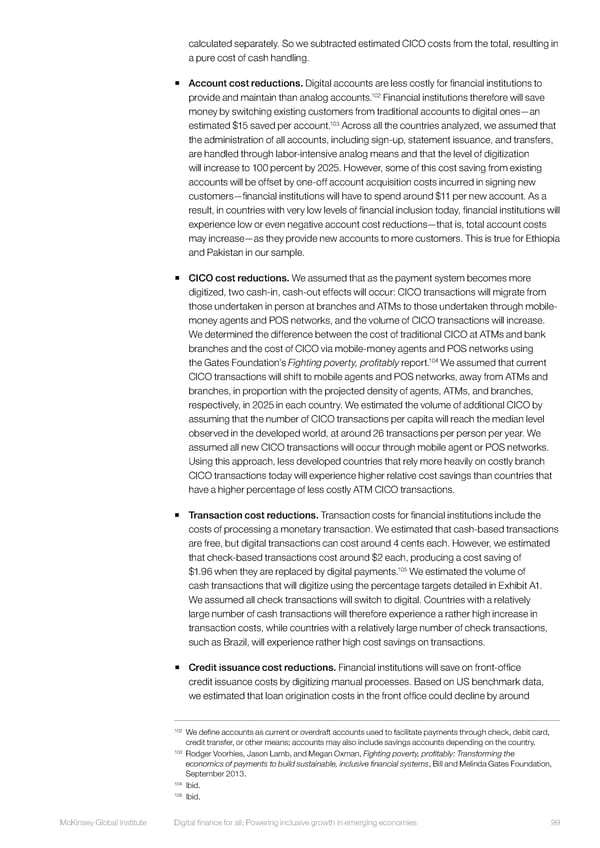calculated separately. So we subtracted estimated CICO costs from the total, resulting in a pure cost of cash handling. ƒ Account cost reductions. Digital accounts are less costly for financial institutions to 102 Financial institutions therefore will save provide and maintain than analog accounts. money by switching existing customers from traditional accounts to digital ones—an 103 Across all the countries analyzed, we assumed that estimated $15 saved per account. the administration of all accounts, including sign-up, statement issuance, and transfers, are handled through labor-intensive analog means and that the level of digitization will increase to 100 percent by 2025. However, some of this cost saving from existing accounts will be offset by one-off account acquisition costs incurred in signing new customers—financial institutions will have to spend around $11 per new account. As a result, in countries with very low levels of financial inclusion today, financial institutions will experience low or even negative account cost reductions—that is, total account costs may increase—as they provide new accounts to more customers. This is true for Ethiopia and Pakistan in our sample. ƒ CICO cost reductions. We assumed that as the payment system becomes more digitized, two cash-in, cash-out effects will occur: CICO transactions will migrate from those undertaken in person at branches and ATMs to those undertaken through mobile- money agents and POS networks, and the volume of CICO transactions will increase. We determined the difference between the cost of traditional CICO at ATMs and bank branches and the cost of CICO via mobile-money agents and POS networks using 104 We assumed that current the Gates Foundation’s Fighting poverty, profitably report. CICO transactions will shift to mobile agents and POS networks, away from ATMs and branches, in proportion with the projected density of agents, ATMs, and branches, respectively, in 2025 in each country. We estimated the volume of additional CICO by assuming that the number of CICO transactions per capita will reach the median level observed in the developed world, at around 26 transactions per person per year. We assumed all new CICO transactions will occur through mobile agent or POS networks. Using this approach, less developed countries that rely more heavily on costly branch CICO transactions today will experience higher relative cost savings than countries that have a higher percentage of less costly ATM CICO transactions. ƒ Transaction cost reductions. Transaction costs for financial institutions include the costs of processing a monetary transaction. We estimated that cash-based transactions are free, but digital transactions can cost around 4 cents each. However, we estimated that check-based transactions cost around $2 each, producing a cost saving of 105 We estimated the volume of $1.96 when they are replaced by digital payments. cash transactions that will digitize using the percentage targets detailed in Exhibit A1. We assumed all check transactions will switch to digital. Countries with a relatively large number of cash transactions will therefore experience a rather high increase in transaction costs, while countries with a relatively large number of check transactions, such as Brazil, will experience rather high cost savings on transactions. ƒ Credit issuance cost reductions. Financial institutions will save on front-office credit issuance costs by digitizing manual processes. Based on US benchmark data, we estimated that loan origination costs in the front office could decline by around 102 We define accounts as current or overdraft accounts used to facilitate payments through check, debit card, credit transfer, or other means; accounts may also include savings accounts depending on the country. 103 Rodger Voorhies, Jason Lamb, and Megan Oxman, Fighting poverty, profitably: Transforming the economics of payments to build sustainable, inclusive financial systems, Bill and Melinda Gates Foundation, September 2013. 104 Ibid. 105 Ibid. McKinsey Global Institute Digital finance for all: Powering inclusive growth in emerging economies 99
 DIGITAL FINANCE FOR ALL Page 116 Page 118
DIGITAL FINANCE FOR ALL Page 116 Page 118